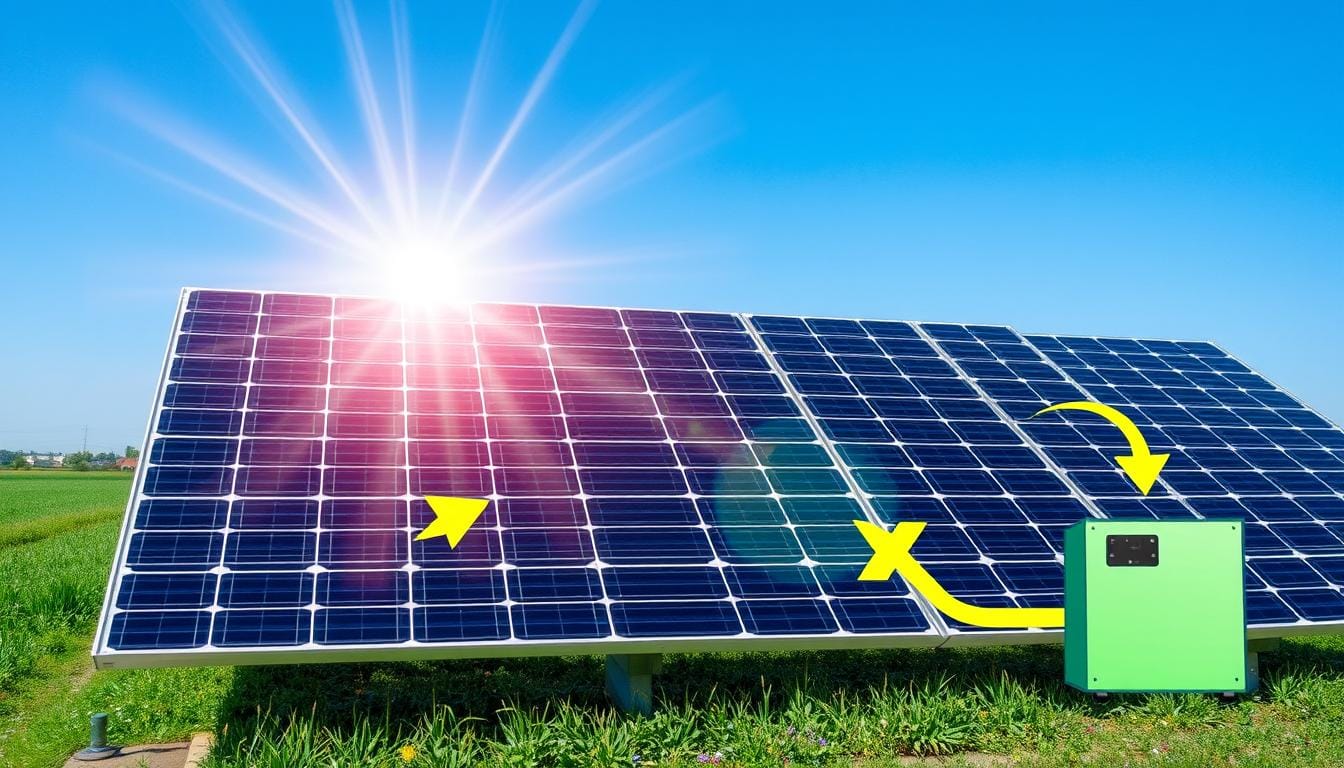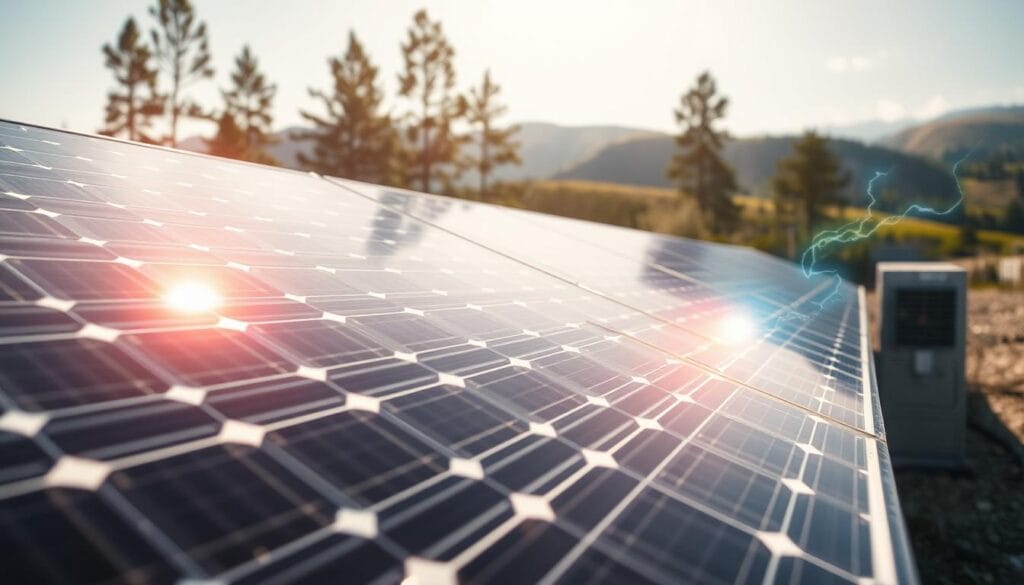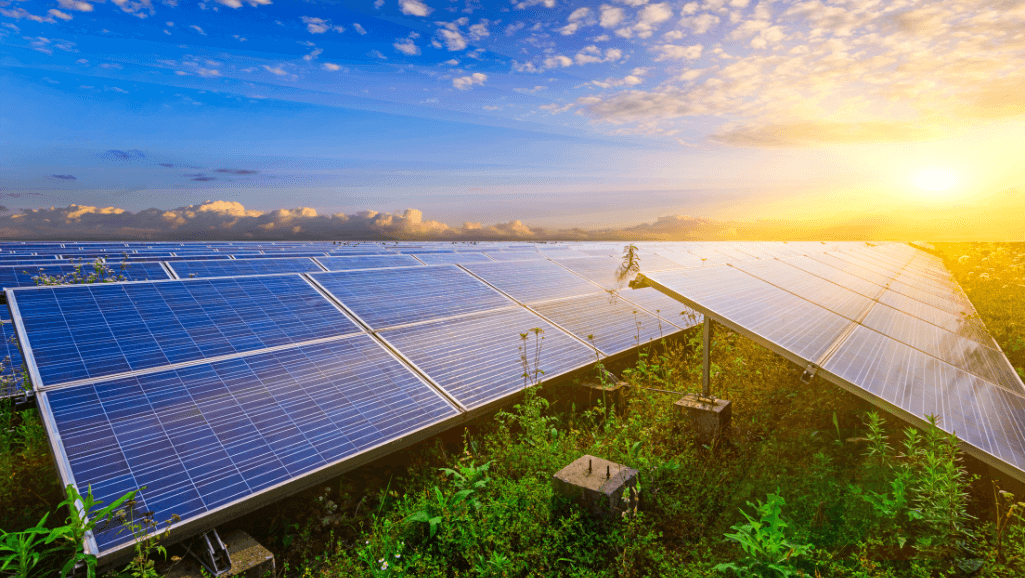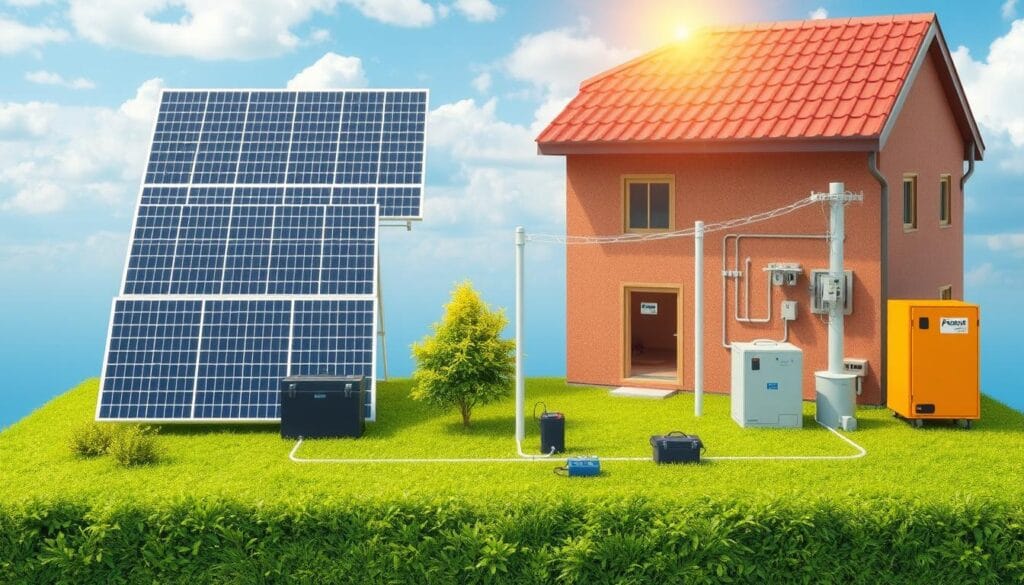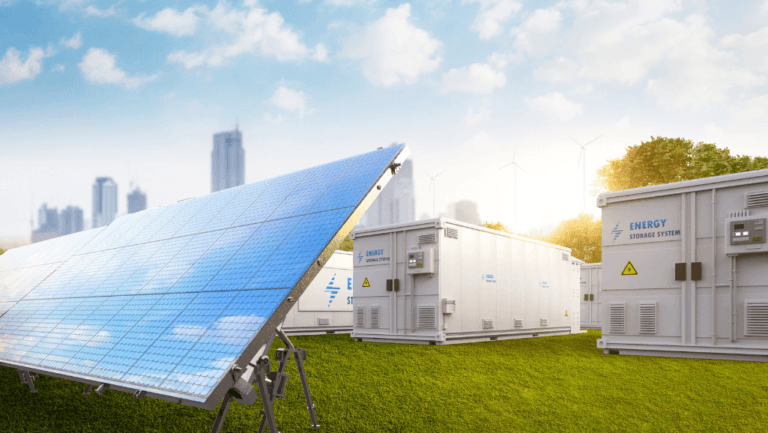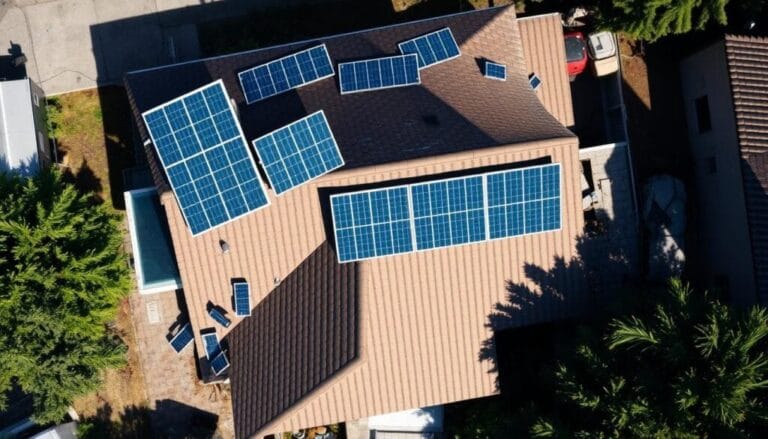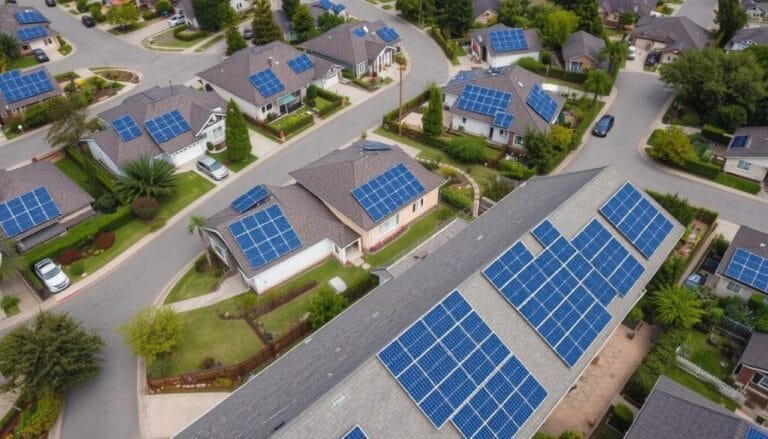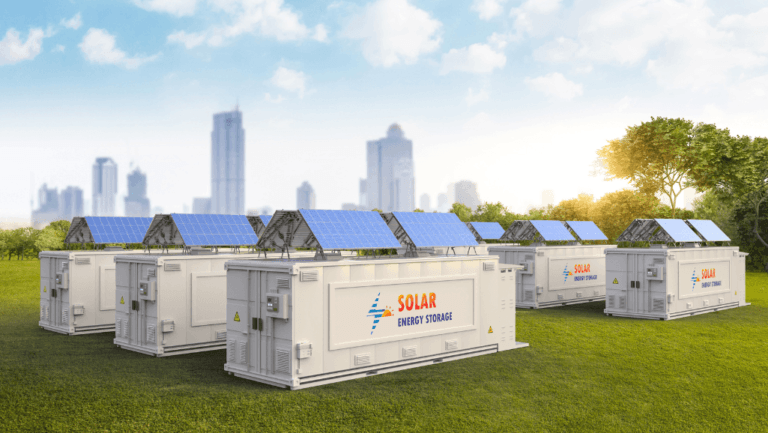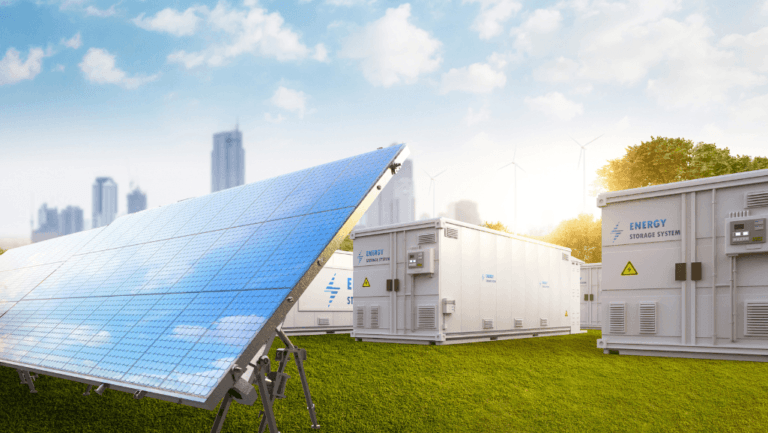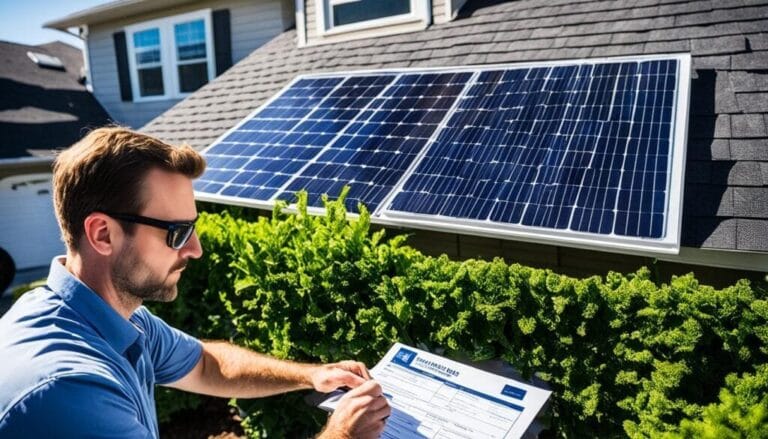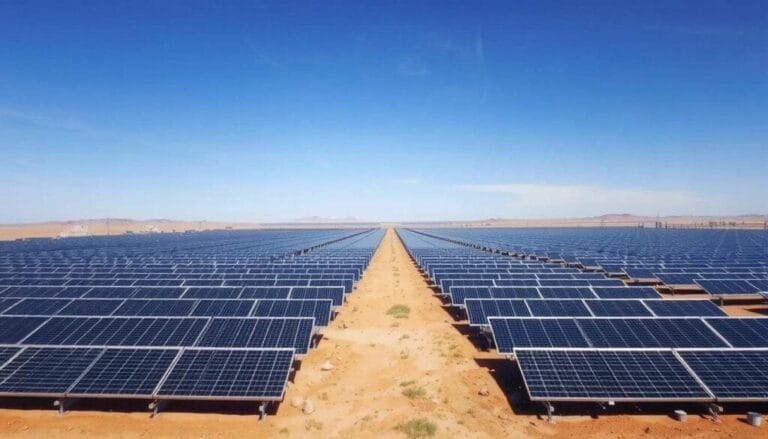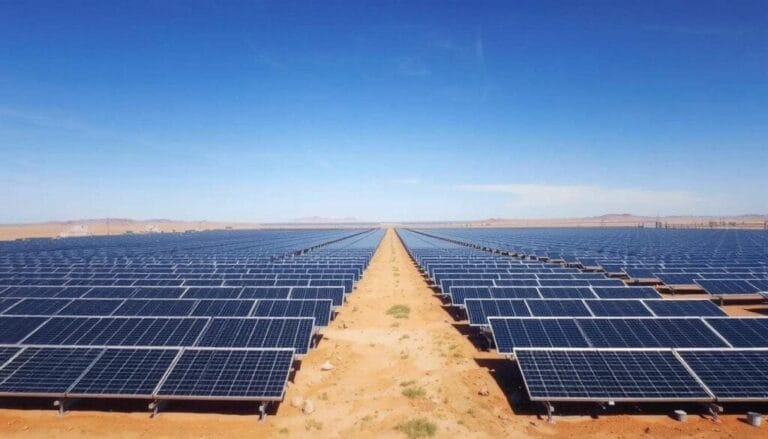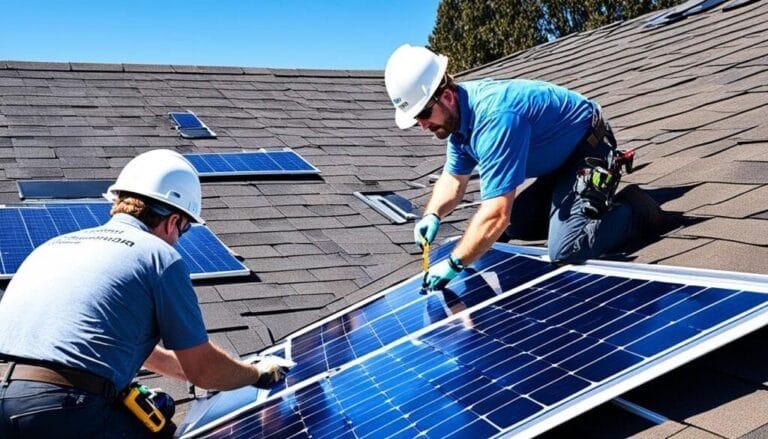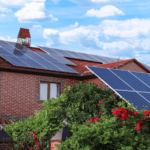The quest to use the sun’s energy has made solar panel electricity conversion both possible and more efficient. The sun can power the world’s energy needs in just an hour and a half of sunlight. This shows how crucial it is to turn solar energy to electrical energy. With solar technologies, we’ve created ways like photovoltaic (PV) panels to use the sun’s power. These innovations let us power homes, appliances, and industries with an endless, renewable energy source.
To understand this amazing achievement, we need to look at how solar panels work. They have silicon cells, wire grids, and protective glass layers. When sunlight hits these parts, it starts a process that moves electric currents into our power grids. Improving this process, like making it easier to add to our power systems and cutting costs, is an ongoing effort in solar research and innovation.
Key Takeaways
- how is solar energy transformed into electricity.
- The solar energy to electrical energy conversion process uses a clean, abundant resource.
- Photovoltaic cells, mainly made of silicon, are key in turning sunlight into electricity.
- Parts like the charge controller, battery, and inverter are crucial for using solar power in daily life.
- New advancements aim to make the process more efficient, reduce costs, and overcome hurdles, keeping solar energy a top renewable choice.
- Even with challenges like needing enough sunlight and storage, the environmental perks and potential for energy freedom make solar crucial.
The Fundamental Principles of Solar Energy
Exploring the basics of solar energy helps us understand renewable energy better. At its heart, it’s about catching solar radiation and turning it into electricity. This mainly happens through photovoltaic (PV) technology.
Understanding Solar Radiation
Solar radiation is a mix of energy from the sun that hits the Earth. This energy is key for making electricity in photovoltaic cells. How well solar power works depends on how much sunlight it gets. This can change based on where you are and the weather.
The Role of Photovoltaic (PV) Technology
Photovoltaic technology is crucial for renewable energy. It uses materials like silicon to turn sunlight into electricity. When sunlight hits PV cells, it starts making electricity.
This process is part of photovoltaic cell energy conversion. It answers the question: how is solar energy transformed into electricity?
Solar panels, with many PV cells, work with inverters and batteries to make a complete system. This system stores and uses the power well. It makes solar energy a dependable power source for homes and businesses.
| Component | Function | Impact on Energy Conversion |
|---|---|---|
| Inverters | Convert DC to AC | Essential for electricity usability in home appliances |
| DC Optimizers | Perform MPPT on each panel | Enhance individual panel performance |
| Microinverters | Enable independent panel operation and convert DC to AC | Eliminate the need for central inverters, increasing system reliability |
| MC4 Connectors | Link panels within systems | Essential for scalability and maintenance of panel arrays |
Modern tech has made solar systems better. As shown by the latest solar tech advances, new things like bifacial panels and AI help make solar power better and more popular.
With ongoing research and new tech, solar energy is a top choice for clean power. Knowing how solar works is key to seeing its huge potential for a greener future.
From Sunlight to Energy: How Photovoltaic Cells Work
Learning about solar power generation starts with understanding how photovoltaic (PV) cells turn sunlight into electricity. This process relies on the photovoltaic effect. It’s a way that solar panels, made of materials like silicon, catch sunlight and change it into electrical current.
At the heart of a solar panel is the PV cell, often made of silicon. It’s great at catching light and turning it into electrical energy. These cells have two silicon layers with different charges, p-type and n-type silicon. When sunlight hits them, it makes electrons move from one layer to the other, creating electric current. This is key to converting sunlight to electricity.
Here are some important stats to help explain this process better:
| Year | Efficiency of PV Panels | Electricity Generation from Utility-scale PV plants (in billion kWh) | Electricity Generation from Small-scale PV systems (in billion kWh) |
|---|---|---|---|
| Mid-1980s | <10% | – | – |
| 2015 | ~15% | – | – |
| 2023 | ~25% | 162 | 74 |
Over the years, PV panels have gotten much better at what they do, making solar power more effective. The big jump in electricity made from solar shows how important solar power is becoming for our energy needs.
Improvements in photovoltaic technology mean better efficiency and more people can use solar power. PV cells are key in making converting sunlight to electricity. They help power everything from small gadgets to whole neighborhoods. With millions of solar systems connected to the grid, solar energy is leading the way to a cleaner planet.
How is solar energy transformed into electricity
To turn solar energy into electricity, we need to look closely at how photovoltaic (PV) cells work. These cells start with silicon, a material known for its ability to convert sunlight into electricity.
The Semiconductor Silicon in PV Cells
Silicon is common in soil, sand, and rocks. It’s key to making solar panels work. These panels use PV cells made from silicon, either monocrystalline or polycrystalline. Monocrystalline cells are more efficient but take up less space. Polycrystalline cells are cheaper and work well for larger areas.
Creation of Electron-Hole Pairs and Electricity
When sunlight hits a PV cell, it makes electrons move. This creates electron-hole pairs that help make electricity. This process, called the photovoltaic effect, was first found in 1839. It’s the basis for using solar energy today.
Learn more about solar power to understand how it turns sunlight into electricity. This shows how solar panels work together to make a big impact on our energy use.
| Aspect | Description | Impact |
|---|---|---|
| Material Used | Silicon in PV Cells | Core element in photovoltaic cell operation |
| Efficiency | Monocrystalline vs. Polycrystalline | Monocrystalline cells are more efficient |
| Solar Energy Utilization | Solar panels converting photons | Direct electricity generation through the photovoltaic effect |
| Environmental Impact | Reduces greenhouse gas emissions | Significant decrease in pollution, enhancing public health |
| Policy and Scalability | Linkage of solar panels in arrays | Facilitates large-scale solar energy generation for the grid |
This look at solar energy shows its tech, environmental, and economic benefits. As solar tech grows, knowing how it works is key for the future and policy making.
Optimizing Solar Energy Utilization: Efficiency and Technology
The world is moving towards sustainable energy, making it key to improve solar energy use and boost solar electricity efficiency. Knowing how solar technology works and what affects its efficiency is crucial. This knowledge helps us make big strides in using renewable energy.
Maximizing Solar Panel Performance
Improving solar panel efficiency depends on design and environmental factors. Solar panels have photovoltaic (PV) cells that turn sunlight into electricity. But, most sunlight doesn’t get turned into electricity because of losses. To get better efficiency, we need to reduce these losses.
- Temperature Control: Solar cells work less well when it’s hot. New materials that keep them cool can help a lot.
- Minimizing Reflection: New coatings stop more light from bouncing off, so panels can catch more sun.
- Material Enhancements: Finding new materials that catch more sunlight is key for better solar panels.
Advancements in Solar Technology
There’s a big push for more efficient solar panels, shown by a huge jump in their use worldwide. From 2005 to 2018, solar PV capacity grew 100 times, showing more trust in solar tech. This is thanks to better efficiency and lower costs. Now, solar PV is even being used in space, opening up new ways to use solar energy.
| Year | Global Solar PV Capacity (MW) | Global CSP Capacity (MW) |
|---|---|---|
| 2010 | 40,334 | 1,266 |
| 2020 | 709,674 | 6,479 |
| Percent Increase | 1,660% | 412% |
The data shows solar PV is growing faster than concentrated solar power (CSP). This trend will likely keep going as we see more tech advances. Things like bifacial modules, which catch sunlight from different angles, are becoming common. Understanding these changes is key to making the most of solar energy.
Various Solar Energy Conversion Methods
Exploring solar energy conversion methods shows us many technologies that use the sun’s power. We see both traditional photovoltaic (PV) systems and new Concentrating Solar-Power (CSP) models. These show how solar panel electricity conversion can work on different scales and in various places.
Photovoltaic technology uses sunlight directly with solar cells, often made of silicon. These cells make electricity by moving electrons around when hit by sunlight. This method works well for homes, where panels can be placed on roofs or in gardens to catch lots of sunlight.
On the other hand, CSP technology focuses sunlight with mirrors to heat a receiver. This heated receiver then makes electricity with steam turbines. This method is great for big power plants and shows how solar energy conversion methods can vary.
When adding solar systems to homes, we also change DC electricity from solar panels into AC electricity. Most home devices use AC. This change happens with inverters, which can be set up in different ways based on the home’s needs.
Using solar energy helps us be more independent and sustainable. Solar systems need little upkeep and can connect to the grid with smart meters. Homeowners can manage their solar power well. They can save money on bills and even make money through net metering, sending extra solar panel electricity conversion back to the grid.
Choosing solar technology means moving toward energy freedom and helping the environment. More solar panels are being added to homes and landscapes. This shows we’re recognizing solar energy’s key role in our future.
Integration of Solar Power into Existing Electrical Grids
The shift to include solar power in our energy systems is a big step towards a sustainable future. Cities like Hurst, TX, Keller, TX, and Southlake, TX are leading the way by using solar energy. It’s crucial to understand how to integrate solar power and the latest tech.
Challenges and Solutions in Solar Energy Integration
One big challenge with solar energy is that the amount of power it produces can change a lot. This affects how well the electrical grids work together. To fix this, we use advanced storage solutions to keep the energy supply steady.
Also, making the grid ready for solar power means it needs to handle electricity flowing both ways. This lets us use the power right away or save it for later.
Inverters are key in making solar power work with our grids. They change the power from solar panels into the kind of electricity our grids use. Microinverters are especially good because they work better and let us check how each panel is doing.
Having good monitoring systems is also important. They help keep the grid running smoothly and fix problems fast. This makes the grid stronger and more reliable.
Net metering helps homeowners by giving them credits for the extra power they send back to the grid. This makes solar power more appealing and affordable. Government tax credits also make solar setups cheaper, helping more people use them.
Improvements in energy storage, like lithium-ion batteries, are key to solving solar power’s ups and downs. These technologies help even out the power supply and make it easier to handle high demand times, like on very hot days.
Smart grid technology is a big help in adding solar energy to our grids. It makes sure energy is used and distributed well, keeping the grid stable and efficient even with more energy sources.
Adding solar power to our grids shows the need to update our energy systems. It’s a move towards a more reliable and green energy system.
Concentrating Solar-thermal Power (CSP): A Different Approach
Concentrating solar-thermal power technology is unique because it turns sunlight into heat, not electricity. This method is great for big energy projects. It can store solar energy for later use.
The Process of Concentrating Solar-thermal Power
This technology uses mirrors to focus sunlight on a receiver. This focused sunlight heats up, creating steam. The steam then turns turbines to make electricity.
This process is efficient and can store energy for later. So, it keeps giving power even when it’s not sunny.
Storing Solar Thermal Energy for Electricity Production
What makes CSP special is its thermal storage system. It saves heat in molten salts. This way, CSP plants can make electricity even when the sun is down.
This is key for meeting power needs and keeping the lights on reliably.
CSP and its storage system are getting better and cheaper over time. Here’s a look at how CSP has improved in recent years:
| Aspect | Details |
|---|---|
| Cost Reduction | Over 50% decrease in the past decade |
| SETO Goals | Target cost of $0.05/kWh for baseload plants with 12+ hours storage |
| Research & Development | Advancements in collectors, receivers, and thermal storage systems |
| Operational Capacity | Solana Station, Arizona: 296 MW; Mojave Project, California: 275 MW |
CSP is changing the game in renewable energy. It shows how new tech can meet both environmental and economic goals. CSP and its storage systems are key to a greener future.
Understanding the Soft Costs of Solar Power
Getting solar power involves more than just buying solar panels and cells. Soft costs of solar energy are key but often missed parts. These include things like permits, financing, and the cost of putting it all together.
Financial aspects of solar power generation are big on these soft costs. They can make up to half of what you spend on solar. This is especially true when dealing with lots of rules and red tape. For example, getting permits can take a long time and cost a lot, depending on where you are.
Connecting solar panels to the power grid is another big soft cost. The rules change from state to state, which can slow things down. This means you might pay more to get your system up and running. Learn more about solar soft costs and how they affect getting renewable energy.
| Aspect | Details | Impact on Costs |
|---|---|---|
| Permitting | Varies by locality, involves paperwork and regulatory compliance. | Increases with bureaucratic complexity. |
| Financing | Securing capital for upfront costs. | Affected by credit terms and availability of financing options. |
| Customer Acquisition | Marketing and sales efforts. | Includes advertising, market research, and sales personnel. |
| Installation | Labor and associated technical activities. | Depends on system complexity and contractor efficiency. |
Knowing about these costs and how to lessen them is key for those thinking about solar power. Working to cut soft costs can make solar energy cheaper and easier to get. This can help make sustainable energy more affordable for everyone.
Solar Energy Storage: Prolonging the Power Supply
Solar energy storage is key to using more renewable energy. It helps keep the power going even after the sun sets. This makes solar power more reliable and useful for everyone.
Solar Batteries and Their Importance in Energy Storage
Solar batteries have changed solar power a lot. They save extra energy made during the day. This energy is used at night or when it’s cloudy. This change has made how we use power at home and in businesses much better.
Technology keeps getting better, making these storage systems more efficient. This means we can use solar power even more in our daily lives.
In the U.S., energy storage is expected to grow a lot by 2025. It will increase sixfold from 2020. This shows more people are using solar energy storage in different areas.
Solar batteries let us use power on our own terms. They also help us make money by selling extra power back to the grid. This makes solar power a smart choice for saving money or earning extra.
Lithium-ion batteries are the top choice for storing solar power at home. They store a lot of energy and last a long time. These batteries work with other systems to manage power well. They make sure we use solar power wisely and keep the power supply steady.
Solar energy storage lowers our energy bills and supports sustainable energy. As we aim for a greener future, solar storage is key. It extends the life of solar power and makes it more dependable. This makes it a crucial part of our energy solutions.
Conclusion
The shift to using solar energy is key in making our energy use sustainable. Solar panels change sunlight into electricity, changing how we think about renewable energy. They need only a clean every two years, making them easy to maintain.
Every solar panel that catches sunlight means we use less oil and gas. This helps our planet stay clean.
Solar power is great for many reasons. It saves money and can even make your home worth more. It also cuts down on harmful emissions.
Plus, solar energy is versatile. It works for homes, businesses, and even in space. Companies like Inter Solar Systems have made big strides in solar technology since 1997.
Ignoring solar energy means missing out on a key way to make our energy cleaner. Solar panels are easy to take care of, needing only the occasional update. They’re a big step towards endless energy, leading us to a future with plenty of clean power.
Switching to solar energy helps us be more independent and protects our planet for the future. It’s a move towards a greener, more resilient world.


